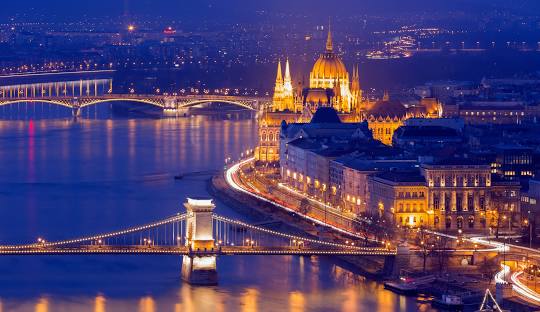Budapest, Hungary
🇭🇺 Budapest, Hungary – The Pearl of the Danube
Overview:
Budapest, Hungary's vibrant capital, is one of Europe's most stunning and dynamic cities, where history, culture, and architecture blend seamlessly. Divided by the majestic Danube River into two distinct districts—Buda and Pest—Budapest is an enchanting mix of medieval castles, grand palaces, and trendy neighborhoods. Known for its stunning bridges, thermal baths, and world-class cuisine, Budapest offers a unique experience that makes it one of Europe’s top destinations.
🏛️ Top Attractions
-
Buda Castle: A UNESCO World Heritage Site, this historic castle complex overlooks the Danube River and houses the Hungarian National Gallery and Budapest History Museum.
-
Parliament Building: The striking neo-Gothic structure on the banks of the Danube is one of Budapest’s most recognizable landmarks and offers guided tours that showcase its ornate interiors.
-
Fisherman’s Bastion: A fairy-tale terrace offering panoramic views of the city, including Parliament, St. Stephen’s Basilica, and the Danube River.
-
Széchenyi Thermal Bath: One of Europe’s largest and most famous thermal bath complexes, a perfect place to relax and soak in Budapest’s wellness culture.
-
St. Stephen’s Basilica: A monumental church with beautiful architecture and the chance to climb its dome for a 360-degree view of the city.
-
Heroes' Square: A grand square dedicated to Hungary’s millennia of history, featuring statues of national leaders and the Millennium Memorial.
🌉 Danube River & Bridges
-
Chain Bridge: The most iconic bridge in Budapest, connecting Buda and Pest, offering stunning views, especially at night when it’s beautifully illuminated.
-
Margaret Island: A tranquil island park in the Danube with beautiful gardens, cycling paths, and the Musical Fountain.
-
Boat Tour: Take a scenic river cruise, where you can enjoy views of the Parliament Building, Buda Castle, and the Gellért Hill.
🍻 Hungarian Cuisine & Drinks
-
Goulash: Hungary’s national dish—a hearty beef and vegetable stew spiced with paprika.
-
Langos: A deep-fried flatbread topped with garlic, sour cream, cheese, and sometimes sausage.
-
Paprikash: A creamy chicken stew flavored with paprika, often served with dumplings.
-
Chimney Cake (Kürtőskalács): A sweet, spiraled pastry baked over an open flame and coated with sugar and cinnamon.
-
Hungarian Wines: Don’t miss tasting Tokaji wine or visiting the Vineyards of Eger for some world-class wine tasting.
-
Palinka: A traditional Hungarian fruit brandy made from various fruits like plum, apricot, and cherry.
🛌 Where to Stay
-
Luxury: Four Seasons Hotel Gresham Palace – A lavish hotel with an art-deco style and spectacular views of the Danube and Chain Bridge.
-
Mid-range: Aria Hotel Budapest – A music-themed boutique hotel offering stylish rooms and a rooftop bar with panoramic views.
-
Budget: Avenue Hostel – A cozy, budget-friendly option with a central location.
-
Unique: Stay in one of the charming ruin pubs in District VII, a cultural and artistic neighborhood where abandoned buildings are transformed into quirky bars and restaurants.
🎭 Festivals & Events
-
Sziget Festival (August): One of Europe’s largest music festivals, featuring global acts in a lively and artistic setting.
-
Budapest Christmas Markets (December): A festive atmosphere with local crafts, warm mulled wine, and delicious street food.
-
Budapest Spring Festival (April): A cultural celebration featuring concerts, theater performances, and art exhibitions.
-
Budapest International Film Festival (April): A major event showcasing independent films from around the world.
🛍️ Shopping & Souvenirs
-
Váci Street: One of the busiest shopping streets in Budapest, offering a mix of local boutiques and international brands.
-
Great Market Hall (Nagy Vásárcsarnok): A vibrant market where you can buy local produce, handmade crafts, and Hungarian specialties like paprika and salami.
-
Handcrafted Goods: Look for Hungarian embroidery, porcelain, and herend porcelain figurines—perfect mementos.
-
Ruin Pub Souvenirs: Get unique items from the quirky ruin pubs of the Jewish Quarter, such as vintage posters, retro trinkets, or local artwork.
🚶♂️ Explore on Foot
Budapest is a wonderfully walkable city with many of its top attractions close to one another. Stroll through the castle district, explore the Danube promenade, and wander through the charming Jewish Quarter. For something a bit offbeat, consider a walk through Várkert Bazaar and Gellért Hill for panoramic views and a break from the crowds.
🌷 Best Time to Visit
-
Spring (March–May): Ideal for mild weather, fewer tourists, and a fresh atmosphere as the city blooms.
-
Summer (June–August): The city comes alive with festivals and outdoor activities, though it can be crowded and warm.
-
Autumn (September–November): A lovely time to visit with fewer crowds and pleasant weather, especially for those looking to enjoy the fall foliage by the Danube.
-
Winter (December–February): Cold but magical, with Christmas markets and a cozy ambiance perfect for a winter escape.
📸 Best Photo Spots
-
Buda Castle at sunset: The golden glow over the castle and the Danube River provides an unforgettable shot.
-
The Chain Bridge at night: A stunning illuminated bridge with the Parliament building in the background.
-
Fisherman’s Bastion: The views from here, with the Parliament and the Danube in the distance, are perfect for a scenic photo.
-
Gellért Hill: A higher vantage point for panoramic views of the city and the river.
🧭 Travel Tips
-
Public Transport: Budapest has an excellent metro system, buses, and trams, making it easy to get around. Consider purchasing a Budapest Travel Card for unlimited rides.
-
Currency: Hungary uses the Hungarian Forint (HUF), so make sure to exchange or withdraw some cash, as some places may not accept cards.
-
Water: Tap water is safe to drink, so you can refill your bottle to save money.
-
Language: While Hungarian is the official language, most people in the tourist areas speak English.
-
Currency Exchange: Avoid exchanging money at airports or exchange offices with high rates. Use ATMs or exchange money at reputable banks.


